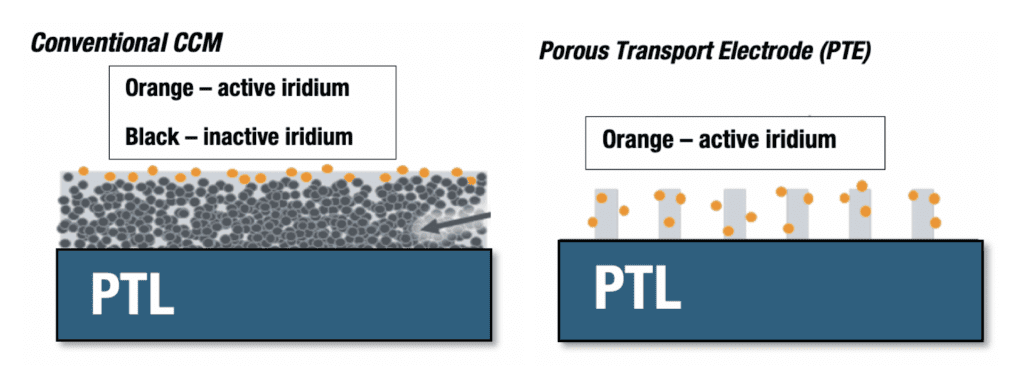Decreasing the dependence on expensive platinum-group metals like iridium is vital for the expansion of “green” hydrogen production via proton-exchange membrane (PEM) water electrolysis. Efforts to develop lower-iridium catalytic components for electrolysis have typically focused on mixing iridium into a polymer slurry with a cheaper material at the core, but these approaches sacrifice current density and catalytic efficiency. Smoltek Hydrogen (Göteborg, Sweden; www.smoltek.com/hydrogen/) has designed an approach for ultra-low iridium loading that maximizes the catalytic surface area while increasing iridium utilization ratio.
Unlike traditional catalyst-coated membranes (CCMs), where a slurry of iridium particles and ionomers (ink) is coated on a non-conductive polymer membrane, Smoltek’s Porous Transport Electrode (PTE) technology grows carbon nanofibers directly onto a porous titanium substrate, which increases available surface area 30-fold — while using up to 95% less iridium. The “ink” coating method depends on water being able to reach iridium below the coating’s surface, which creates the necessary catalyst surface area. However, there are severe limitations in how thin the coating layer can be made, because lower particle density isolates iridium from the electrical source and cannot achieve the needed active surface area. There are also durability concerns with thin, fragile coating layers.
“In traditional CCMs, it gets crowded inside the slurry. The iridium particles get packed so tightly that water cannot flow in and reach the particles hidden by other particles. Also, the just-created oxygen cannot find its way out of the cell, growing into larger and larger bubbles of oxygen gas. These bubbles also shield iridium from water,” explains Ellinor Ehrnberg, president of Smoltek Hydrogen.

Smoltek Hydrogen
Conversly, she says, depositing iridium directly onto the conductive carbon nanofibers guarantees that all iridium atoms are active and accessible, enhancing the efficiency of the electrochemical process. “The open nanostructure design allows for unobstructed water access to the iridium catalyst and the efficient removal of generated oxygen, preventing bubble formation and ensuring consistent catalytic activity.”
In PEM electrolyzers, Smoltek’s PTE is designed to replace the existing porous transport layer (PTL), as well as the anode catalyst layer coated on the membrane. Smoltek is currently working with a number of customers to evaluate the electrode at the laboratory scale, and in February announced a strategic cooperation with Heraeus Precious Metals to scale up to full-size prototypes and to prepare for full-scale market introduction. “We have achieved promising results in laboratory settings, including producing hydrogen with only 0.1 mg of iridium per square centimeter during a 250-h durability test. This milestone indicates the technology’s potential for scalability and commercial application,” adds Ehrnberg. The company anticipates small-scale industrial production to commence in 2026, and to ramp up to higher-volume production in 2027.